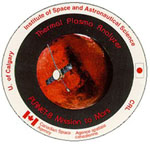|


A Canadian instrument called the Thermal Plasma Analyzer, or TPA, was one of 14 instruments onboard the Japanese satellite Nozomi, a mission designed to study Martian atmosphere and its interaction with solar wind. . The satellite was launched on July 3, 1998 and had a difficult journey. On December 10, 2003, Japanese officials confirmed that it was impossible to place Nozomi in orbit around Mars. With its mission now canceled, the satellite will follow a harmless large elliptic solar orbit.
The Principal Investigators for the TPA project are Drs. Andrew Yau and Greg Garbe of the University of Calgary. This project represents Canada's first interplanetary mission and was sponsored by Japan's Institute of Space and Astronautical Sciences with instrumentation from Canada, Japan, Sweden, Germany, and the United States. Participation in this mission was to provide Canadian researchers with the data from all the other experiments on Nozomi.
|

|

An image of the moon taken September 24, 1998 by the Mars Imaging Camera
(courtesy of ISAS) |
TPA is designed to measure the lowest energy particles and gases, providing information which is considered vital to understanding the origin and composition of Martian atmosphere. The instrument consisted of a sensor mounted at the end of a boom, and a central computer inside the spacecraft. Once in orbit around Mars, the boom was to be extended, allowing the sensor to operate without interference from the spacecraft. |
In April 2002, Nozomi had experienced a very strong solar energetic proton event associated with a strong solar flare. This caused a short circuit in one of the subsystems which made the Mars orbit insertion impossible. Notwithstanding this deceiving lost for the Canadian scientific community, this mission opened doors to future collaborations between Canada and its international partners and made possible some current projects to explore the solar system.
| The Mars Imaging Camera (MIC) sent back images which can be found on the ISAS web site at www.planet-b.isas.ac.jp/MIC/MIC_e.html. They include the first image (of the Earth and the Moon together); and an image of the back of the Moon. |
|